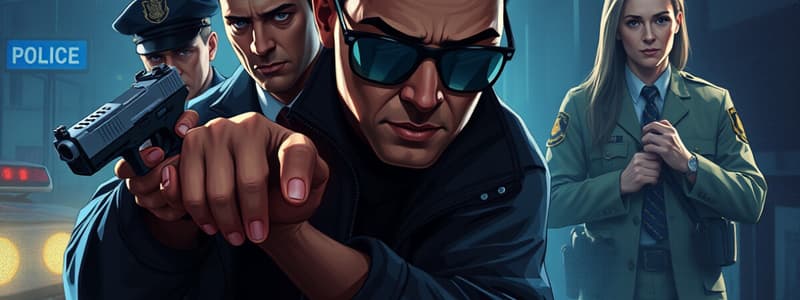Podcast
Questions and Answers
What must an officer do before conducting a show-up with victims/witnesses who have limited English proficiency?
What must an officer do before conducting a show-up with victims/witnesses who have limited English proficiency?
- Proceed without any assistance.
- Skip the interpretation process.
- Obtain an interpreter if feasible. (correct)
- Use a family member as an interpreter.
What is the purpose of reading instructions to victims/witnesses before the show-up?
What is the purpose of reading instructions to victims/witnesses before the show-up?
- To prevent them from identifying anyone.
- To ensure they sign a waiver.
- To inform them of their legal rights.
- To ensure they do not discuss the procedure. (correct)
What information is NOT required for documentation by the officer during a show-up?
What information is NOT required for documentation by the officer during a show-up?
- Sex, age, and race of the subject.
- Alleged crime and outcome of the show-up.
- Victim/witness's employment history. (correct)
- Date, time, and location of the show-up.
What must a victim/witness do for the show-up to proceed after hearing the instructions?
What must a victim/witness do for the show-up to proceed after hearing the instructions?
What should an officer do if a victim/witness makes an identification?
What should an officer do if a victim/witness makes an identification?
What happens if a victim/witness does not identify anyone during the show-up?
What happens if a victim/witness does not identify anyone during the show-up?
Which scenario allows for the showing of a single photograph to a victim/witness?
Which scenario allows for the showing of a single photograph to a victim/witness?
What must the officer document regarding the victim/witness during a show-up?
What must the officer document regarding the victim/witness during a show-up?
What should a victim/witness do if they identify someone during a show-up?
What should a victim/witness do if they identify someone during a show-up?
What is NOT a potential use for a single photograph shown to a victim/witness?
What is NOT a potential use for a single photograph shown to a victim/witness?
What is one condition that must be met for a show-up to be conducted?
What is one condition that must be met for a show-up to be conducted?
Which of the following is NOT a procedural safeguard during a show-up?
Which of the following is NOT a procedural safeguard during a show-up?
What should officers do to minimize suggestiveness during a show-up?
What should officers do to minimize suggestiveness during a show-up?
In which scenario can a show-up be conducted without prior arrangements for a lineup?
In which scenario can a show-up be conducted without prior arrangements for a lineup?
What must officers do when multiple victims or eyewitnesses are present?
What must officers do when multiple victims or eyewitnesses are present?
Which of the following is crucial for the identification process in domestic violence cases?
Which of the following is crucial for the identification process in domestic violence cases?
What is NOT a requirement for the environment where a show-up is conducted?
What is NOT a requirement for the environment where a show-up is conducted?
What should NOT occur during a show-up involving a suspect?
What should NOT occur during a show-up involving a suspect?
What is a necessary action for officers during a show-up if the suspect poses an imminent threat?
What is a necessary action for officers during a show-up if the suspect poses an imminent threat?
Which of the following is a key factor in minimizing suggestiveness during a show-up?
Which of the following is a key factor in minimizing suggestiveness during a show-up?
Flashcards are hidden until you start studying
Study Notes
Show-Up Procedures Overview
- Procedures minimize suggestiveness when displaying a subject to a victim/witness.
- Officers must gather a detailed description of the suspect before conducting a show-up.
Conditions for Conducting Show-Ups
- Must occur shortly after the crime and near its location, based on reasonable suspicion.
- Alternatives like live or photographic lineups should be unavailable.
- Eyewitness must feel capable of identifying the suspect.
Specific Identifications
- Applicable for identifying intimate relationships in domestic violence cases.
- Used to confirm familial identities (parent, child, sibling).
Transport and Environment
- Victims/witnesses should be transported separately to the show-up location.
- Ensure a well-lit area with an unobstructed view of the subject.
- Avoid suggestive external factors (e.g., comments, radio traffic).
Subject Presentation Protocol
- Subjects should not wear clothing or mimic actions from the crime scene.
- Subjects should not be shown in handcuffs or patrol vehicles, except in cases of imminent threat.
Conduct During Multiple Identifications
- One victim/witness at a time for viewing.
- Separate subjects during show-ups if multiple suspects exist.
- Maintain separation of victims/witnesses from each other.
Documentation and Recording
- Record details using body-worn cameras.
- Include specific details like date, time, location, demographics of subjects, and outcome of identification.
Special Considerations
- Interpreters should be used for witnesses with limited English or hearing impairments.
- Explain the identification process thoroughly beforehand.
Instructions to Victims/Witnesses
- Clear communication about the identification process and its significance is vital.
- Emphasize no obligation to identify; assurance of ongoing investigation regardless of their choice.
Assessment of Identification Confidence
- Upon identification, officers should gauge the victim/witness's confidence level.
- Capture the identification statement in the victim/witness’s own words.
Follow-Up Procedures
- If there's no identification, obtain suspect details for release, and document the encounter.
- Single photographs may be shown for specific cases like known suspects or domestic situations.
Studying That Suits You
Use AI to generate personalized quizzes and flashcards to suit your learning preferences.





